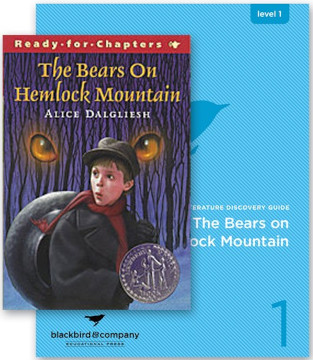Blackbird & Company Literature Discovery Guides are written for well-known children’s literature. The guides and their corresponding books are divided into five levels: earlybird for grade 2, level 1 for grade three, level 2 for grades four and five, level 3 for grades six through eight, and level 4 for high school. There are 20 to 35 guides per level. Blackbird & Company bundles the guides as grade-level collections and as part of their complete language arts packages for each grade level, but you can also purchase them individually.
Earlybird level
Earlybird guides are for children who might not yet read well independently. Earlybird guides should each take about six weeks to complete, so you will use four earlybird guides for a full school year. The children’s picture books selected for each guide are briefer than for the other levels, so each guide covers four or five books that are either by the same author, such as Virginia Lee Burton or Robert McCloskey, or revolve around a single theme, such as weather or music. The guides ask students to draw and write. You might take dictation for some assignments if the amount of writing is too much for a young student. The sixth week is dedicated to a final project selected from a list of suggestions.
Levels 1 through 4
For levels 1 through 4, each guide covers one book and should take about five weeks to complete. This means that you would select six guides for each level to put together a program for the year. Literature selections are a mix of classic and current selections such as Ben and Me, Flat Stanley, Because of Winn Dixie, The Magician's Nephew, Across Five Aprils, I Am David, The Mozart Season, The Book Thief, and Of Courage Undaunted.
These guides are premised on the idea expressed in the introduction to each guide that “the emotional, intellectual, and spiritual components of a story are inseparable.” While the guides for levels 1 through 4 teach comprehension and basic literary analysis skills, they also teach children to think deeply about ideas, principles, and beliefs that motivate both the characters in stories and students themselves.
Levels 1 through 4 break books down into four groups of chapters so that each group of chapters represents a week’s worth of work. The fifth week is dedicated to a final project selected from a list of suggestions; final projects primarily involve reading, research, and writing at upper levels and offer more arts-and-crafts options for lower levels. Level 4 adds an essay assignment for the fifth week.
Each week’s work follows a similar format in levels 1 through 3, but at increasingly challenging levels. Students begin by reading the assigned chapters. Either while reading or after, they will journal on character development for a few key characters, the setting, and the plot (what is happening in this part of the story). This is followed by a vocabulary exercise. Next is a page with comprehension questions that guide students to write sentences summarizing the plot of each week’s reading. Students are then to write a paragraph (with a topic sentence, supporting evidence, and conclusion) in response to a writing prompt based on the week’s reading. Students will craft a rough draft of a paragraph, then polish that paragraph after conferencing with their teacher. Lessons conclude with a substantial set of eight or nine discussion questions. While these might be discussed between only a student and a parent, they really lend themselves to group discussion. It might be worth gathering a group that meets once a week for only the discussion.
The level 4 guides for high school are similar in many respects to those for levels 1 through 3, but students will do significantly more writing. Many pages have lines for them to take notes, write synopses, copy intriguing quotations from the reading, write sentences for vocabulary words, and write reflections on the week's assigned reading. Some of the writing assignments assign a specific word length such as a 300-word reflection. As I mentioned earlier, they will also write a literary essay during the last week of each study. Instructions and models for the essay are included along with a Student Self-Evaluation form and Teacher's Feedback form. In addition, rather than provide discussion questions, the guide directs students to craft their own discussion questions "for your discussion group" each week. While this assumes a group class meeting, a student could come up with questions to discuss with a parent instead.
Each guide for levels 1 through 4 contains an assignment checklist. This allows students to pace themselves through all elements of their assignments. Rubrics for evaluation are included.
Parents and Teachers
One of the goals of these guides is to cultivate curiosity and imagination and to encourage students to dig for deeper meaning. This can only be accomplished well through discussion, so if you purchase these guides, do so with a plan to read the novels and fully participate in the learning process with your child(ren).
No answer keys are included in the guides. Answers should be easy for the earlybird level. For levels 1 through 3, you can find answer keys on the publisher’s website with page numbers in the novels where answers can be found for the comprehension questions. Level 4 has no answer keys since all journaling at the high school level is subjective. No suggested responses are given for discussion questions.
Summary
These guides are, in some ways, more comprehensive than many others since they combine basic skills in vocabulary, comprehension, and literary analysis with deeper and more meaningful thinking skills that are drawn out through compositions and discussions.








